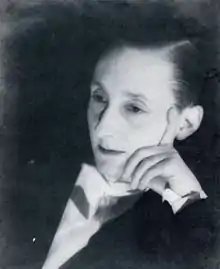Marlow Moss
Marjorie Jewel "Marlow" Moss (29 May 1889 – 23 August 1958) was a British Constructivist artist who worked in painting and sculpture.
Marjorie Jewel "Marlow" Moss | |
|---|---|
 | |
| Born | Marjorie Jewel Moss 29 May 1889 Kilburn, London |
| Died | 23 August 1958 (aged 69) Penzance, Cornwall |
| Nationality | British |
| Education | St John's Wood Art School, Slade School of Fine Art, Académie Moderne |
| Known for | Painting |
| Movement | Constructivism |
| Partner(s) | Antoinette Hendrika Nijhoff-Wind |
Biography
Moss was born on 29 May 1889 in Kilburn in London.[1] She was the daughter of Lionel and Fannie Moss.[2] She studied at St John's Wood Art School, the Slade School of Fine Art, and the Académie Moderne.[3]
In her childhood music was her one great interest, but her music studies were interrupted for years when she contracted tuberculosis. Later Moss turned her attention to ballet.[4] Around 1919 she changed her forename (from Marjorie) and adopted a masculine appearance.[5] This was precipitated by a ‘shock of an emotional nature’ and the abandonment of her studies at the Slade, to live alone in Cornwall.[6][7]
Moss was a pupil of Fernand Léger and Amédée Ozenfant at the Académie Moderne. She was associated with Piet Mondrian and they mutually influenced each other's use of the double line.[3][8] She was a founding member of the Abstraction-Création association and was the only British artist to feature in all five annuals published by the group.[9][10]
At the beginning of World War II Moss left France to live near Lamorna Cove in Cornwall, studying architecture at the Penzance School of Art. For the rest of her life she lived and worked in Cornwall, frequently visiting Paris. A neighbour, in Lamorna, described her as ″a dear little soul″ who use to give all the children of the village a Christmas present. The neighbour, when a child used to peer into her studio to watch her paint,[11]
... we'd see her pacing up and down, pacing, pacing. And then she would draw a straight line. Her work was all straight lines and cubes. Then she'd pace up and down again and then – uh, a square would be drawn.
Individual exhibitions of her work were staged by Erica Brausen in the Hanover Gallery in London in 1953 and 1958. Other exhibitions took place in the Stedelijk Museum, Amsterdam, in 1962 and in the Town Hall of Middleburg in Spring 1972.[4]
Collections
Moss's work is in the collection of the Israel Museum, the Stedelijk Museum Amsterdam, the Kröller-Müller Museum in Otterlo, the Kunstmuseum Den Haag, the Museum of Modern Art in New York, and Tate, UK.[9]
Writings
- Moss, Marjorie (1932). "[Puisque c'est le but de cet almanach d'introduire le public le domaine de l'art non-figuratif...]". Abstraction-création: Art non-figuratif (in French). 1: 26.
- Moss (1933). "[Quelle est l'influence des arbres sur ma peinture?]". Abstraction-création: Art non-figuratif (in French). 2: 29.
References
- "Marlow Moss". RKD. Retrieved 2 January 2020.
- "Moss, Marlow [formerly Marjorie Jewel] (1889–1958), artist". Oxford Dictionary of National Biography. 2004. doi:10.1093/ref:odnb/64505.
- Lebovici, Élisabeth. "Marlow Moss". AWARE Women artists / Femmes artistes. Retrieved 2 January 2020.
- Marlow Moss (1890-1958): constructions, drawing, paintings. Zurich ; London: Gimpel & Hanover Galerie ; Gimpel Fils. 1973.
- Phaidon Editors (2019). Great women artists. Phaidon Press. p. 288. ISBN 978-0714878775.
- Nijhoff, A. H. (1962). Marlow Moss. Amsterdam: Stedelijk Museum.
- Darwent, Charles (2014-08-25). "Marlow Moss: forgotten art maverick". the Guardian. Retrieved 2016-05-22.
- Howarth, Lucy (2019). Marlow Moss. London: Eiderdown Books. pp. 6–14. ISBN 978-1-9160416-2-2. OCLC 1108726309.
- Howarth, Lucy. "Marlow Moss: Space, Movement, Light". Tate. Retrieved 2 January 2020.
- Howarth, Lucy (2019). Marlow Moss. London: Eiderdown Books. p. 5. ISBN 978-1-9160416-2-2. OCLC 1108726309.
- Hockin, Hazel (2000). Some Lamorna Voices. Lamorna: The Lamorna Oral History Group. pp. 13–18.
Further reading
- Dijkstra, Florette (1995). Marlow Moss: Constructivist + the Reconstruction Project. Translated by Wright, Annie. Penzance, Cornwall: De Kleine Kapaciteit and The Patten Press. ISBN 1-872229-26-3.
- Howarth, Lucy (2008). Marlow Moss (1889–1958) (PhD). University of Plymouth. hdl:10026.1/2528.
- Schaschl, Sabine, ed. (2017). A Forgotten Maverick : Marlow Moss (in German and English). Berlin: Hajte Cantz. ISBN 978-3-7757-4300-6.
External links
- Marlow Moss, Tate Collection
- Spatial Construction in Steel (1956-7), Henry Moore Institute